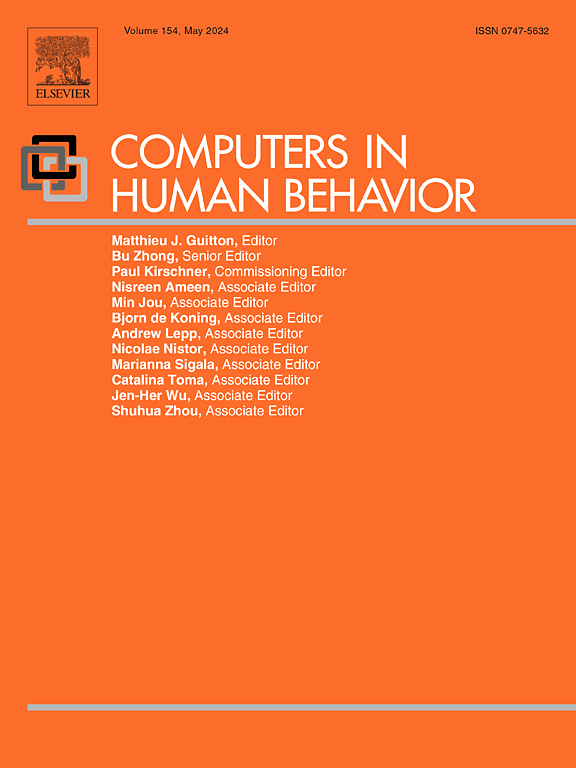不仅仅是像素:为什么关系,而不仅仅是内容,让用户留在虚拟世界
IF 9
1区 心理学
Q1 PSYCHOLOGY, EXPERIMENTAL
引用次数: 0
摘要
像“第二人生”这样的沉浸式虚拟世界能够形成深度的人际关系,可以与线下形成的人际关系相媲美或超越。本研究利用定性和调查数据的混合方法,调查了《第二人生》(SL)中的社会纽带如何提高平台留存率和参与度。利用社会存在理论、副社会互动理论和媒体丰富度理论,我们分析了视频叙述和用户调查反馈,以了解用户不断返回SL的原因。定性研究结果(分为主题类别并附有支持性引用)揭示了SL关系被认为是真实的、情感丰富的,并得到了强烈的存在感的支持。用户描述了真实世界中的真爱、友谊和社区支持,往往模糊了虚拟和现实之间的界限。一项在线调查(N = 188)的定量结果显示,在SL中建立密切关系的用户表现出较高的持续粘性;95%的受访者表示,他们“可能”或“肯定”会继续使用SL,主要原因是他们在现实世界中的关系。综上所述,这些复杂的发现表明,人际关系——甚至比内容更重要——是虚拟世界中用户长期留存的关键因素。我们讨论了虚拟社区设计和理论的意义,强调了虚拟社区中的社会存在、副社会动态和媒体丰富性如何共同培养深厚的联系和忠诚度,为虚拟平台设计师提供了实际意义,并对在线社交生活有了更广泛的见解。本文章由计算机程序翻译,如有差异,请以英文原文为准。
More than pixels: Why relationships, not just content, keep users in virtual worlds
Immersive virtual worlds like Second Life enable the formation of deep interpersonal relationships that can rival or exceed those formed offline. This study investigates how social bonds in Second Life (SL) enhance platform retention and engagement, using a mixed-methods approach with qualitative and survey data. Drawing on Social Presence Theory, Parasocial Interaction, and Media Richness Theory, we analyze video narratives and user survey responses to understand why users keep returning to SL. The qualitative findings – structured into thematic categories with supporting quotes – reveal that SL relationships are perceived as authentic, emotionally rich, and supported by a strong sense of presence. Users describe genuine love, friendship, and community support in-world, often blurring the line between virtual and real. Quantitative results from an online survey (N = 188) show that users who form close relationships in SL report high ongoing engagement; 95 % of survey respondents said they “probably” or “definitely” will continue using SL, frequently citing their in-world relationships as a primary reason. Together, the mixed findings suggest that relationships – even more than content – are a key driver of long-term user retention in virtual worlds. We discuss implications for virtual community design and theory, highlighting how social presence, parasocial dynamics, and media richness in SL jointly foster deep bonds and loyalty, offering practical implications for virtual platform designers and broader insights into online social life.
求助全文
通过发布文献求助,成功后即可免费获取论文全文。
去求助
来源期刊

Computers in Human Behavior
Multiple-
CiteScore
19.10
自引率
4.00%
发文量
381
审稿时长
40 days
期刊介绍:
Computers in Human Behavior is a scholarly journal that explores the psychological aspects of computer use. It covers original theoretical works, research reports, literature reviews, and software and book reviews. The journal examines both the use of computers in psychology, psychiatry, and related fields, and the psychological impact of computer use on individuals, groups, and society. Articles discuss topics such as professional practice, training, research, human development, learning, cognition, personality, and social interactions. It focuses on human interactions with computers, considering the computer as a medium through which human behaviors are shaped and expressed. Professionals interested in the psychological aspects of computer use will find this journal valuable, even with limited knowledge of computers.
 求助内容:
求助内容: 应助结果提醒方式:
应助结果提醒方式:


